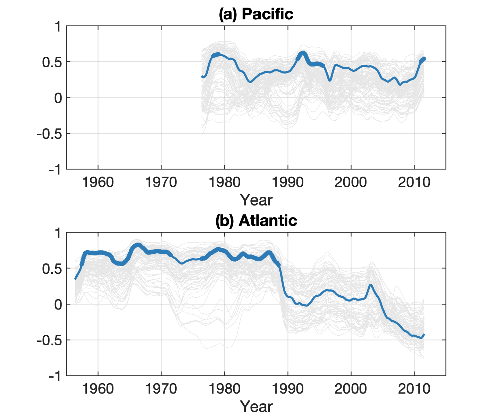




read more











Hence, further work is required on the matter. The authors showed that dissimilarities between Japanese and American inshore sea level emerge in the second mode of variability. Because the tide gauge networks in both oceans extend further back in time than the period analysed in this study, inshore sea level has potential for reconstruction of the variability of the ocean circulation mode of variability. Although the causal630 link between the upstream sea level and the meridional shifts of WBC extensions is not yet completely understood, their results suggest that upstream inshore tide gauges, such as Key West ( available from 1913 in the PSMSL revised local reference ( RLR ) database ), Fernandina Beach ( 1897 ) or Hosojima ( 1930 ) could be used as proxies for the extension meridional shifts and, by extension, the forcing responsible for such meridional shifts.
Because the tide gauge networks in both oceans extend further back in time than the period analysed in this study, inshoresea level has potential for reconstruction of the variability of the ocean circulation mode of variability.
the surge correction reduces the variance north of Cape Hatteras, which better constrains the EOF analysis and reduces undesired compensation between modes.
Both across-shore and alongshore wind stresses can impact sea level as can variations in the local air pressure through theInverse Barometer (IB) effect.
The role of WBCs in the redistribution of heat and salt in the Atlantic is an integral part of the Atlantic Meridional Overturning Circulation (AMOC), resulting in heat transported towards the equator in the South Atlantic and the largest heat transport of any ocean northwards in the North Atlantic (Bryden and Imawaki, 2001).
The randomly generated signals are then correlated against B. Significance for zero-lag correlation between A and B is given as the percentage of randomly generated correlations which are less than the correlation between A and B (using absolute values).
For each year up to 2019, the available sparse subsurface temperature observations were interpolated at the climatological position of the Gulf Stream and KuroshioExtensions using an inverse distance weighting technique with power parameter p= 2 and a search radius of 400 km, allowing235construction of an along-jet temperature matrix.
In addition, the local forcing of the atmosphere drives an important part of the coastal sea-level variability, particularly in shelf environments.
The authors make use of the GSNW index from Joyce et al. (2000) and of the Kuroshio Extension indices from Qiu et al. (2016), and also derive in Sect. 2.3 indices for the variability of the two WBC extensions.
In the615absence of such information, the mechanism proposed by Sasaki et al. (2014) is, so far, the only linking the upstream sea-level and the WBC extensions’ meridional shifts.